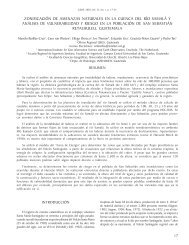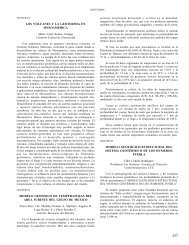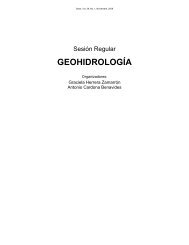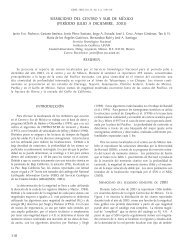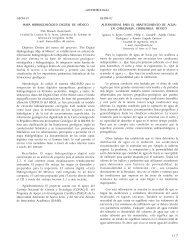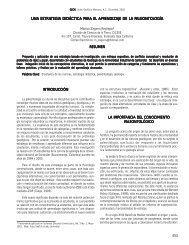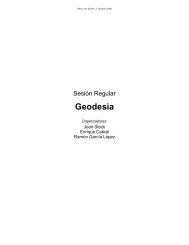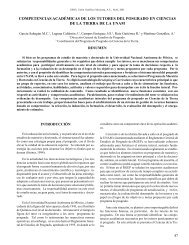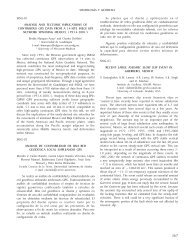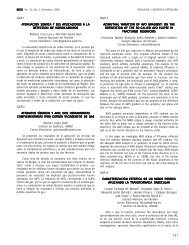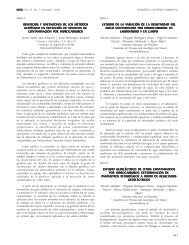Libro de resúmenes [revisión final, 172 páginas] - UGM
Libro de resúmenes [revisión final, 172 páginas] - UGM
Libro de resúmenes [revisión final, 172 páginas] - UGM
Create successful ePaper yourself
Turn your PDF publications into a flip-book with our unique Google optimized e-Paper software.
Geos, Vol. 27, No. 1, Octubre, 2007MODELADO DE PROCESOS GEOLÓGICOS Y GEOFÍSICOSboundary started to <strong>de</strong>velop. During this stage, volcanic activitymostly occurred in the form of monogenetic fields displayinga large variability in composition ranging from adakites tohigh-Mg an<strong>de</strong>sites, though some younger calc-alkaline activityalso occurred. The volcanic fields are scattered throughout thewestern margin of the peninsula forming well-<strong>de</strong>fined clusters,whereas the younger calc-alkaline activity is spread along its eastmargin.The origin of post-subduction volcanism has been attributed toregional tectonic events such as the subduction of an active ridgesegment, the breakoff of the Farallon slab, or the propagation ofa tear on the subducted plate. However, new <strong>de</strong>velopments onthe theory of volcanic systems (Canon-Tapia and Walker, 2004),indicate that volcanism is strongly influenced by local stresses andthe tensile strength of the rocks overlying the zones where partialmelting is taking place. In the light of such observations, we builta finite element mo<strong>de</strong>l for the stress change in the Baja Californiapeninsula, which may provi<strong>de</strong> a more a<strong>de</strong>quate explanation tothe provenience of the post-subduction volcanism. The mo<strong>de</strong>lconsists of an elastic layer representing the North America plateresting on an incompressible viscous fluid approximating themantle rheology. Deformation in the mo<strong>de</strong>l is driven by forces inthe mantle of viscous and buoyant nature, which in turn <strong>de</strong>pendon the imposed boundary conditions. Next, we supplied the mo<strong>de</strong>lwith the different boundary conditions that prevailed during thedistinct tectonic stages the area un<strong>de</strong>rwent through the last 12.5Ma, (i.e., active subduction, end of subduction, and opening of theGulf of California), to obtain the state of stress insi<strong>de</strong> the elasticplate.Numerical experimentation shows that during the activesubduction stage, a tensional-stress build up was present in theComondu volcanic arc, suggesting a control of the stress fieldon the emplacement of volcanism. The mo<strong>de</strong>l for the end ofsubduction (12.5 to 6.5 Ma) indicates that a significant change inthe state of stress took place in the area; the entire elastic plateis now un<strong>de</strong>r tension, which may have promoted the re-activationof old fractures and allowed the continuation of volcanic activityduring this period. As for the last stage, the mo<strong>de</strong>l shows thattensional stresses increased one or<strong>de</strong>r of magnitu<strong>de</strong> along thebase of the elastic plate. Once again, the state of stress predictedby the mo<strong>de</strong>l is in good agreement with the observed geologicrecord, which shows a renewed pulse of post-subduction volcanicactivity in the peninsula for this time.SE01-11EXPERIMENTOS FÍSICOS DE ACORTAMIENTOSOBRE DESPEGUES CON DIFERENTE REOLOGÍACOMO AYUDA EN LA INTERPRETACIÓNDE LA EVOLUCIÓN ESTRUCTURALPortillo Pineda Rodrigo y Cerca Martínez MarianoCentro <strong>de</strong> Geociencias, UNAMrokdrigo14-83@hotmail.comSe realizó una serie <strong>de</strong> experimentos <strong>de</strong> mo<strong>de</strong>lado analógicocon el objetivo <strong>de</strong> estudiar la influencia <strong>de</strong> las diferenciasen el comportamiento mecánico <strong>de</strong> la capa <strong>de</strong> <strong>de</strong>spegueen el <strong>de</strong>sarrollo <strong>de</strong> estructuras acortadas, en zonas someras<strong>de</strong> la corteza terrestre. Los mo<strong>de</strong>los tienen una geometríaque simula una estratificación mecánica consistente en unbasamento quebradizo, una capa intermedia <strong>de</strong> <strong>de</strong>spegue(dúctil), y sobre estas una capa <strong>de</strong> cobertura quebradiza. Enel caso <strong>de</strong> comportamiento quebradizo se emplea arena quesimula una ruptura que sigue el criterio <strong>de</strong> Mohr-Coulomb, uncomportamiento similar al <strong>de</strong> las rocas que se <strong>de</strong>forman enniveles superiores <strong>de</strong> la corteza. Para el comportamiento dúctilse emplea un polímero (silicón SGM 36) con un comportamientomecánico similar al <strong>de</strong> evaporitas, que fue mezclado condiferentes cantida<strong>de</strong>s <strong>de</strong> arena para cambiar su viscosidad. Lascurvas <strong>de</strong> flujo <strong>de</strong> las mezclas silicón-arena cumplen con lacondición <strong>de</strong> similitud dinámica. Los mo<strong>de</strong>los no representanun prototipo natural específico, sin embargo se consi<strong>de</strong>ro unescalamiento geométrico similar al que ocurre en algunas zonasacortadas <strong>de</strong>l noreste <strong>de</strong> México. De esta manera 1 cm en elmo<strong>de</strong>lo representa 1 km en la naturaleza, y esto arroja un valor <strong>de</strong>L*= 1x10-5. Mo<strong>de</strong>lamos en condiciones <strong>de</strong> gravead normal g=1.La <strong>de</strong>nsidad <strong>de</strong> la arena que se utiliza para los experimentos seencuentra entre 1520-1600 kg/m3 y los valores <strong>de</strong> <strong>de</strong>nsidad enla naturaleza para la corteza superior se encuentran alre<strong>de</strong>dor<strong>de</strong> 2650-2700 kg/m3. El valor <strong>de</strong> escalamiento <strong>de</strong> esfuerzosse encuentra entre: esfuerzo=(<strong>de</strong>nsidad*)(g*)(L*)=5.73x10-3 . Latasa <strong>de</strong> <strong>de</strong>formación en nuestros experimentos es ~1.1x10-3, querepresenta ~ 1 mm/año en la naturaleza y es un valor razonable<strong>de</strong> <strong>de</strong>formación.Todos los mo<strong>de</strong>los fueron acortados 40 %. Los resultadosfueron analizados e interpretados con la ayuda <strong>de</strong> imágenes,aéreas y <strong>de</strong> sección, obtenidas en lapsos <strong>de</strong> tiempo regularesdurante la <strong>de</strong>formación. Al <strong>final</strong> <strong>de</strong>l experimento se cortansecciones transversales <strong>de</strong>l mo<strong>de</strong>lo. Los resultados fueron lossiguientes: En el caso I se utilizo arena homogénea y redon<strong>de</strong>ada<strong>de</strong> cuarzo con un coeficiente <strong>de</strong> fricción menor que las capasbasal y superior, se <strong>de</strong>sarrolla una cuña <strong>de</strong> tipo friccionalrepresentado por fallas inversas y retrocabalgaduras. En el casoII don<strong>de</strong> se utilizaron las diferentes mezclas <strong>de</strong> silicón-arena,estas actuaron como capa <strong>de</strong> <strong>de</strong>spegue que permitieron diferentegrado <strong>de</strong> <strong>de</strong>sacoplamiento entre la capa basal y <strong>de</strong> cobertura ypermitieron el <strong>de</strong>sarrollo <strong>de</strong> variaciones en el estilo estructuralescon pliegues <strong>de</strong> <strong>de</strong>spegue, pliegues <strong>de</strong> caja, cabalgamientos,retrocabalgamientos, estructuras “pop-up”. El estilo estructuralresultante en los experimentos es controlado por las condicionesiniciales <strong>de</strong> viscosidad y la <strong>de</strong>nsidad <strong>de</strong> la capa <strong>de</strong> <strong>de</strong>spegue.En el caso III se utilizaron micro esferas cerámicas con un bajoángulo <strong>de</strong> fricción (~. 21°) como capa <strong>de</strong> <strong>de</strong>spegue. Finalmente,la comparación <strong>de</strong> los resultados con secciones publicadas <strong>de</strong>zonas acortadas nos pue<strong>de</strong> ayudar en la interpretación sobre suevolución estructural.SE01-12GEOMORFOLOGÍA Y VECTORES DE DESPLAZAMIENTOEN CINTURONES DE PLIEGUES Y CABALGADURASSIMULADOS EN EXPERIMENTOS FÍSICOSCerca Martínez Mariano 1 , Barrientos García Bernardino 2 , GarcíaMárquez Jorge 2 , Portillo Pineda Rodrigo 1 y Hernán<strong>de</strong>z Bernal Caridad 31 Centro <strong>de</strong> Geociencias, UNAM2 Centro <strong>de</strong> Investigación en Óptica, A.C.3 Instituto <strong>de</strong> Geología, UNAMmcerca@geociencias.unam.mxEn este trabajo analizamos la evolución <strong>de</strong> los vectores<strong>de</strong> <strong>de</strong>splazamiento sobre la superficie <strong>de</strong> experimentos físicos<strong>de</strong> cinturones <strong>de</strong> pliegues y cabalgaduras sobre un <strong>de</strong>spegue(<strong>de</strong>collément) viscoso. La combinación <strong>de</strong> dos métodos ópticos,proyección <strong>de</strong> franjas y fotografía <strong>de</strong> moteado láser, nos permitióobtener la <strong>de</strong>formación 3D <strong>de</strong> la superficie difusa <strong>de</strong>l mo<strong>de</strong>lo.La componente fuera <strong>de</strong>l plano es medida mediante la técnica<strong>de</strong> proyección <strong>de</strong> franjas mientras que los <strong>de</strong>splazamientos 2D145


![Libro de resúmenes [revisión final, 172 páginas] - UGM](https://img.yumpu.com/51565067/145/500x640/libro-de-resamenes-revisian-final-172-paginas-ugm.jpg)
